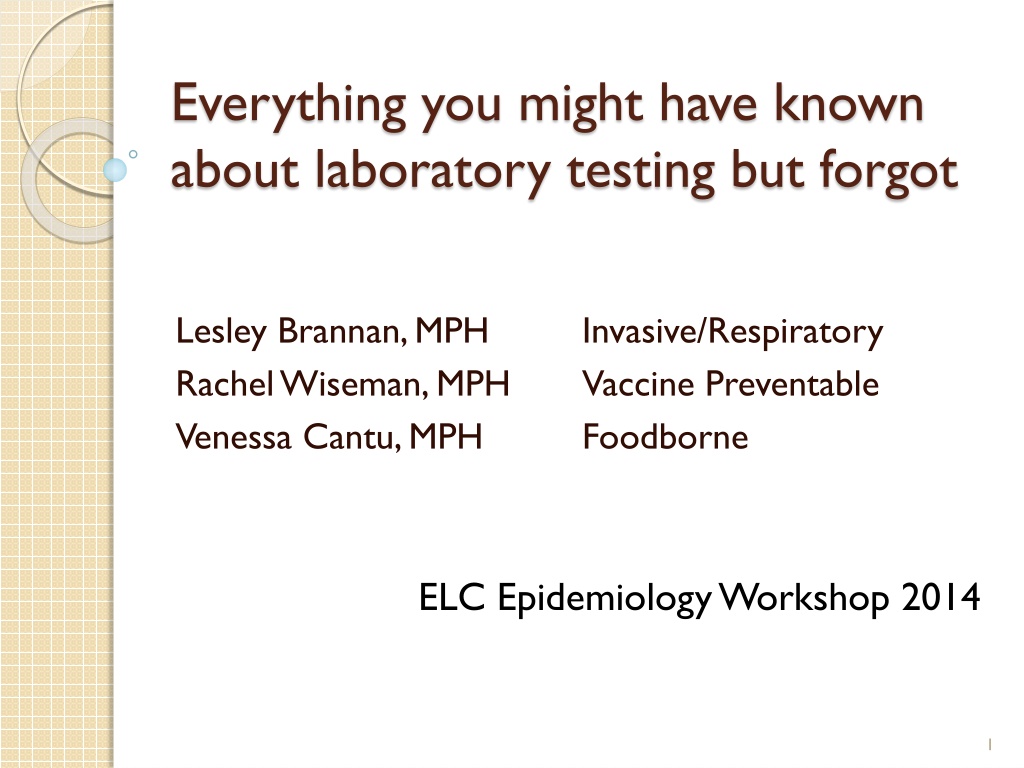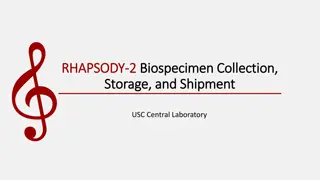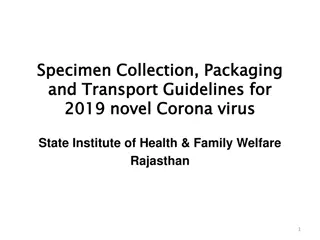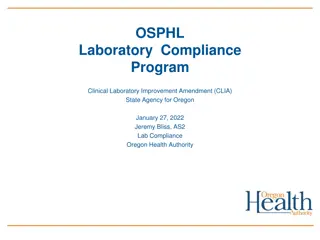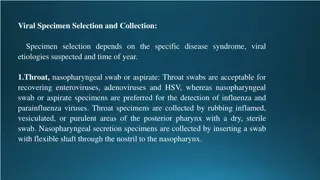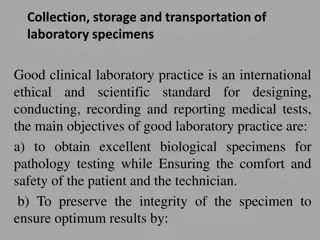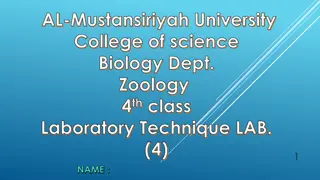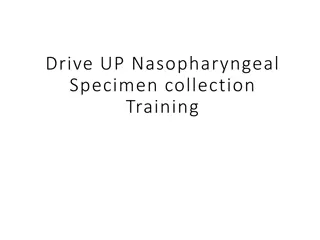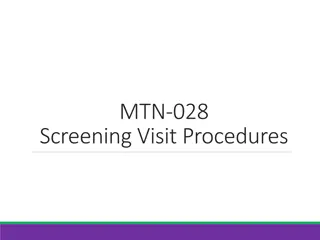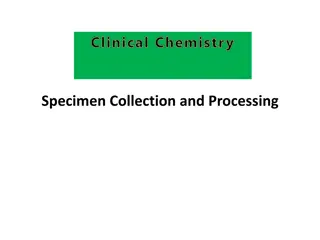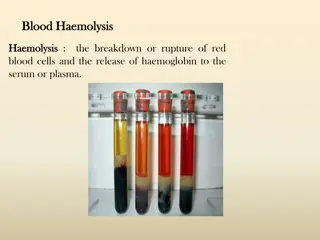Laboratory Testing and Specimen Submission Guidelines
Comprehensive guidelines and procedures for laboratory testing, specimen submission, ordering supplies, filling out forms, CDC submissions, and packaging/shipping. Includes information on DSHS lab accounts, specimen forms, ordering supplies, and shipping protocols. Proper submission procedures and contact information are emphasized for efficient and accurate processing.
Download Presentation

Please find below an Image/Link to download the presentation.
The content on the website is provided AS IS for your information and personal use only. It may not be sold, licensed, or shared on other websites without obtaining consent from the author. Download presentation by click this link. If you encounter any issues during the download, it is possible that the publisher has removed the file from their server.
E N D
Presentation Transcript
Everything you might have known about laboratory testing but forgot Lesley Brannan, MPH Rachel Wiseman, MPH Venessa Cantu, MPH Invasive/Respiratory Vaccine Preventable Foodborne ELC Epidemiology Workshop 2014 1
How to Submit Specimens to the Lab Do you have a DSHS lab account? Find your office s lab submitter number OR get a submitter number Is your HD s contact information current? Do you have current versions of all of the submitter forms? G-2A, G-2B, G-2V, G-27A, G-??? http://www.dshs.state.tx.us/lab/mrs_forms.shtm#Microbi ological (Note: these are SAMPLE forms only and cannot be used for submission) Email Labinfo@dshs.state.tx.us or contact Lab Reporting at 512-776-7578 2
Ordering Supplies Foodborne and pertussis supplies Order using G-6A form: http://www.dshs.state.tx.us/lab/mrs_forms.shtm#Microbiol ogical Questions? Contact Lab Container Preparation Group at (512) 776-7661 MMR and influenza-type supplies must be ordered through EAID MMR Contact Rachel Wiseman Influenza/respiratory outbreaks (non-VPD) Contact flutexas@dshs.state.tx.us Have a sufficient number of supplies on hand in case of outbreaks!!! 3
Filling out the Forms Each specimen needs a form Form should be completely filled out Information on form should match information on specimen (e.g. name, DOB) Form(s) should be included in shipment with specimen(s) 4
CDC Submissions CDC prefers specimens to be sent from state labs. If testing at CDC is indicated, coordinate submitting specimens through DSHS Central Office/Laboratory, unless given different instructions. 5
Packaging/Shipping Packaging Triple-contained Use appropriate labeling for boxes Most specimens are Biological substance category B For Category A agents, check with lab directly Use enough ice packs/dry ice to maintain temperature (if applicable) Include submission forms in shipment Shipping Send overnight mail Use FedEx or courier of choice Don t ship on Friday or the day before a state holiday Use physical address (1100 W 49th, lab services) for FedEx, couriers 6
Common Reasons for Rejection Specimen not received within appropriate timeframe after collection No form or form incorrect Information on specimen doesn t match information on form No information on specimen container Submitted at wrong temperature Expired media/supplies Submitted on wrong media Specimen tube leaking or broken When in doubt, contact Central Office or the lab! 8
Accessing ResultsLabWare Get access to LabWare: https://results- web.dshs.state.tx.us:8443/index.jsp Click on EPI registration (very bottom right) Fill out PHLIMS confidentiality form AND Fill out the EPI account registration Most DSHS results are in LabWare CDC results will need to be reported separately (usually via fax) Many results will show up in NBS 9
Invasive/Respiratory Infectious Diseases VIRAL RESPIRATORY OUTBREAKS (NON-VPD) 10
When to Collect Specimens Collect outbreak specimens on: Outbreaks/clusters in facilities (nursing homes, schools, jails, etc.) Unknown etiology or etiology suspected but not confirmed Flu outbreaks without subtyping results or only rapid test results Pathogens under consideration Bacterial should be tested by private or hospital labs (or sometimes CDC) Viral common viral respiratory pathogen testing available at DSHS Austin 11
Specimen Collection Supplies Have sufficient supplies on hand! Supplies available: Viral transport medium (VTM) for viruses DSHS-prepared or commercially-prepared Nasopharyngeal (NP) swabs Secondary containers for packaging specimens Labeled boxes and cold packs for shipping FedEx waybills for prepaid shipping Note: Dry ice & dry ice labels are not provided by DSHS Supplies will arrive within 1-2 business days of request (if urgent) 12
Specimen Collection Specimen types: NP swab required for viral respiratory PCR panel testing Other specimen types (e.g., throat swab) will only get influenza PCR testing Collect specimens within 4-5 days of onset Try to submit 5-10 specimens per outbreak Specimen submission rules: If refrigerated and shipped on cold packs, lab must receive specimens within 72 hours of collection If frozen and shipped on dry ice, no time restrictions from collection to submission 13
Lab Submission Form Submission form: G-2V In addition to submission form tips mentioned earlier in this presentation, do the following: Virology (Section 4): Check Influenza surveillance {Influenza real-time RT-PCR} , AND Write Outbreak investigation in white space Outbreak investigation Payor source (section 6): Check IDEAS to avoid bill for submitter 14
Testing Who does it? Flu PCR test: DSHS Austin, Laboratory Response Network (LRN) labs, private labs Respiratory viral panel PCR test: DSHS Austin, private labs Flu PCR test (public health labs) Flu A H1, H3, 2009 H1; Flu B Turnaround time: 2-5 days Individual specimen results reported to submitter Respiratory viral panel PCR test (DSHS Austin) Rhinovirus, respiratory syncytial virus, human metapneumovirus, influenza, parainfluenza 1-3, adenovirus Turnaround time: 1-4 weeks* Results reported in aggregate to DSHS Austin EAIDB (public health use only) Note: Prior epidemiology approval/notification required for testing 15
Other Testing Suspect enterovirus - DSHS can culture Mycoplasma CDC tests Bacterial testing, including Strep usually performed at private labs or hospitals Legionella Urine antigen test for patient specimens at private labs (most common) DSHS tests patient clinical specimens and pure cultures DSHS tests environmental isolates only if patient isolate(s) available for comparison Legionella water testing available from ELITE certified labs Pathology specimens tested by CDC Pathology Lab upon request Unknown etiology/severe If death, CDC Pathology Lab can test If outbreak, options may be available after consultation with CDC URDO (Unexplained Respiratory Disease Outbreaks) Group 16
Invasive/Respiratory Infectious Diseases NOVEL INFLUENZA & NOVEL CORONAVIRUS 17
When to Collect Specimens Collect specimens from patients who meet criteria for a Patient Under Investigation (novel coronavirus) or a Case Under Investigation (novel flu) Usually involves: Specific symptoms or diagnoses Specific exposure (one or more of the following may be required): Travel, within 10-14 days of onset, to a specified area where the novel pathogen has been detected, OR Epi-linked to a confirmed case, OR Unprotected laboratory exposure (novel flu), OR Recent contact with swine or other animal populations (H3N2v), OR Part of a severe illness cluster of unknown etiology (novel coronavirus) See CDC s website for most up-to-date case criteria: Novel influenza H5N1: http://www.cdc.gov/flu/avianflu/h5n1/case-definitions.htm (Revised Jan 2014) H7N9: http://www.cdc.gov/flu/avianflu/h7n9/case-definitions.htm (Rev Jan 2014) H3N2v: http://www.cdc.gov/flu/swineflu/case-definitions.htm Novel coronavirus: http://www.cdc.gov/coronavirus/mers/case-def.html 18
Specimen Collection Supplies For novel viruses, specimen collection should begin ASAP! Hospitals/providers should be encouraged to use their own collection supplies, if available Regions/locals should keep supplies on hand in case of need If requested, supplies will arrive within 1-2 business days of request from DSHS Austin Supplies available same as for influenza surveillance and viral (non-VPD) respiratory outbreaks Media, NP swabs, secondary containers, labeled boxes and cold packs, prepaid FedEx waybills 19
Specimen Collection Specimen types: Novel flu Upper respiratory specimens preferred Lower respiratory specimens may be requested Novel coronavirus Lower respiratory specimens most important for virus detection/recovery Also requested: NP and OP swabs, sera (acute and convalescent), stool Collect specimens as close to onset as possible See CDC guidance for full recommendations: Novel flu: http://www.cdc.gov/flu/avianflu/h7n9/specimen- collection.htm (H5N1, H7N9) Novel coronavirus: http://www.cdc.gov/coronavirus/mers/guidelines-clinical- specimens.html 20
Lab Submission Form Submission Form: G-2V In addition to submission form tips mentioned earlier in this presentation, do the following: Novel Influenza Virology (Section 4): Check Influenza surveillance {Influenza real-time RT-PCR} , AND Write Suspect novel flu in white space, AND Note travel history and animal contact, if any Novel Coronavirus Virology (Section 4): Check Other: and write in MERS Coronavirus on the adjacent line General information for novel virus testing Payor source (Section 6): Check IDEAS to avoid bill for submitter Note: Prior epidemiology approval/notification required for testing 21
Testing Who does it? Novel flu: DSHS Austin, LRN labs, (private labs) Novel coronavirus: DSHS Austin only Novel Flu Testing DSHS Austin and LRN labs can test for: H5N1, H7N9, H3N2v Other novel flu subtypes (unsubtypeable result) Novel Coronavirus Testing In Texas, testing only performed at DSHS Austin lab General information for novel virus testing Prior epidemiology notification and approval required for testing Turnaround time: generally within 24 hours of receipt Individual specimen results reported to submitter as presumptive positive Presumptive positive results sent to CDC for confirmation 22
Invasive/Respiratory Infectious Diseases MENINGOCOCCAL DISEASE, INVASIVE 23
Specimen Submission Highlights Submission of Neisseria meningitidis isolates from normally sterile sites or purpuric lesions required by law Texas Administrative Code (Title 25, Part 1, Chapter 97, Subchapter A, Rule 97.5) DSHS lab serogroups all N. meningitidis isolates Currently licensed US vaccines only cover serogroups A, C, Y, & W-135 Outbreaks of serogroup B recently on college campuses DSHS lab performs PFGE analysis on all N. meningitidis isolates to identify disease clusters 24
IRID Team Contacts Lesley Brannan Team Leader, Epidemiologist Outbreaks, coronavirus, influenza, all diseases (Vacant position) Influenza Surveillance Coordinator, Epidemiologist Influenza, RSV Michael Fischer CJD Surveillance Coordinator, Epidemiologist Creutzfeldt-Jakob disease, amebic meningitis, coronavirus Irina Cody Public Health and Prevention Specialist Meningococcal disease, legionellosis Amy Littman Public Health and Prevention Specialist Streptococcal diseases (GAS, GBS, Strep pneumo) Robert Russin ILINet Coordinator, Public Health and Prevention Specialist Influenza 25
Vaccine Preventable Diseases MEASLES, MUMPS, RUBELLA TESTING 26
Measles, Mumps, Rubella Overview Measles, mumps, rubella require lab testing to meet case definition Testing for these is very similar Preferred testing is PCR Done off-site at MN DOH for measles, rubella Mumps done at DSHS Measles PCR is not available at commercial labs Preferred site is throat for measles, rubella; cheek swab for mumps Serology (IgM and IgG) is also useful Done at DSHS Can be tested at Minnesota or CDC, if indicated Widely available commercially 27
MMR: Supplies You Need G-2A for serology G-2V for virology (includes PCR) Viral transport media (e.g. Remel) Pharyngeal (throat) swabs Synthetic with plastic/aluminum handle Serum separator tubes or gold top tubes Centrifuge Cold packs or dry ice Shipping materials 28
MMR: Getting Supplies You can purchase them Any viral transport media will do You should be able to use PHEP funds You can request them from DSHS You can pre-order them in small quantities If needed urgently, we can get them to you overnight (excluding weekends) If requesting from DSHS, contact Rachel Wiseman first 29
MMR: Collection Time Frames Viral swabs should be collected within 10 days of symptom onset. The sooner, the better Serology for IgM should be collected as soon as possible after symptom onset. Small risk of false negative IgM if drawn before day 5 after onset, but don t wait. IgM can be collected up to 30 days after onset. Paired IgG samples should be collected shortly after onset and 2 weeks after onset. 30
MMR: Shipping Time Frames PCR specimens should arrive within 48 hours of collection If longer than 48 hours, must be frozen (-70) Serology specimens should arrive within 48 hours of collection. If longer than 48 hours, must be frozen (-20) If over 48 hours and not frozen, testing at CDC is a possibility Do not ship frozen in serum separator tubes 31
MMR: Important Serology Information Mumps IgM can be falsely negative or positive. Do not use a negative IgM as a rule out in vaccinated individuals. Rubella IgM is frequently falsely positive. It is highly cross-reactive to measles, rheumatoid factor, Epstein-Barr, & pregnancy. Measles IgM can be falsely positive. Send to DSHS lab for confirmatory testing. 32
MMR: Filling Out the G-2A Check IgM and IgG. Make sure you pick correctly between rubella and rubeola. Choose Wisely 33
MMR: Filling out the G-2V MUMPS Measles PCR OR Rubella PCR MEASLES OR RUBELLA DSHS virology lab prefers not to do culture testing; don t mark culture. (PCR is faster) 34
MMR: If Requesting a Lab to Forward a Specimen Ensure they have a G-2A or G-2V. Fill out the G-2A or G-2V for them. Make sure they understand the temperature the specimen needs to be at. Most of the time the answer is FROZEN. Get the tracking number for their shipment. Tell Central Office a specimen is coming. OR Central Office can do all this for you. 35
MMR: Paying for Testing Immunity testing is NOT covered by DSHS. All other MMR testing will be paid for by DSHS. Mark the Immunizations box in the payor section of the G-2 form(s). Do not check other boxes in this section. DSHS will not correct any billing problems if the form was not completed correctly. 36
Vaccine Preventable Diseases VARICELLA 37
When to Test for Varicella Outbreaks Distinguish between wild-type and vaccine strain disease Breakthrough disease May not look like varicella Often misdiagnosed Unfortunately, this can be hard to test 38
Varicella Testing Varicella serology is no longer performed at DSHS. IgM not recommended for diagnosis. Varicella PCR testing is available. DSHS sends specimens to MN DOH or CDC. Providers can send directly to CDC. Biopsies or CSF can be sent for PCR to CDC. Severe cases/deaths Should be shipped frozen 39
Supplies for Varicella PCR Synthetic swabs Transport tubes, NO media Needles Glass slides G-2V form Shipping materials Instructions: http://www.cdc.gov/chickenpox/lab- testing/collecting-specimens.html 40
Collecting Vesicular Specimens Unroof the vesicle (use a sterile needle or slide). Put scab in sealed container for testing. Rub synthetic swab in lesion vigorously! Get vesicular fluid. Get skin cells from base of lesion. Don t make the patient bleed. Place swab in EMPTY transport tubes. Use a different swab for each lesion or scab. One swab or scab per tube. 41
Collecting Maculopapular Specimens Rake edge of slide over lesion. Make sure skin cells scrape off and onto slide. Rub synthetic swab on scraped lesion. Use same swab to collect skin cells from slide. Use a different swab for each lesion. Place swab in EMPTY transport tubes. One swab per tube. 42
VZV Submission Forms Use the G-2V. Check lesion and write in the site (e.g. left arm) in Section 3, Specimen Source. In Section 4, check other and write in VZV PCR. Mark Immunizations as payor source in Section 6. (If testing for smallpox, use the G-27A) 43
VZV Collection and Shipping Best to collect within 5 days of rash onset. Collect from at least 2 lesions. Vesicles and scabs are preferred. A good rub is better than no test. Ship at room temperature. Can use regular mail. Can ship whenever after collection (but don t wait too long). 44
Vaccine Preventable Diseases PERTUSSIS 45
Pertussis Testing DSHS lab can do culture. It requires special media for collection/transport that the submitter has to obtain. It cannot be done on what is submitted for pertussis PCR. Pertussis PCR is widely available. Testing at DSHS lab should be paid for by the submitter. DSHS only pays for outbreak specimens in certain circumstances. You must get permission first. 46
Pertussis Testing Supplies G-2B form NP swab Synthetic with plastic/aluminum handle Transport tube, NO media Cold packs Shipping materials http://www.cdc.gov/pertussis/clinical/downl oads/diagnosis-pcr-bestpractices.pdf 47
Vaccine Preventable Diseases OTHER VPDS 48
H. influenzae Labs can forward cultures/isolates to DSHS for ID and/or serotyping Please request for all cases under five Raw specimens can also be sent for culture, ID and serotyping Sterile site specimens only Use G2B Results will be in NBS, regardless of type 49
Hepatitis A, B Serology available at DSHS Serology widely available commercially Apart from special studies, commercial labs should be used We will contact you to request specimens DSHS lab can be used for perinatal hepatitis B testing Check Immunizations in payor box on G2A 50
